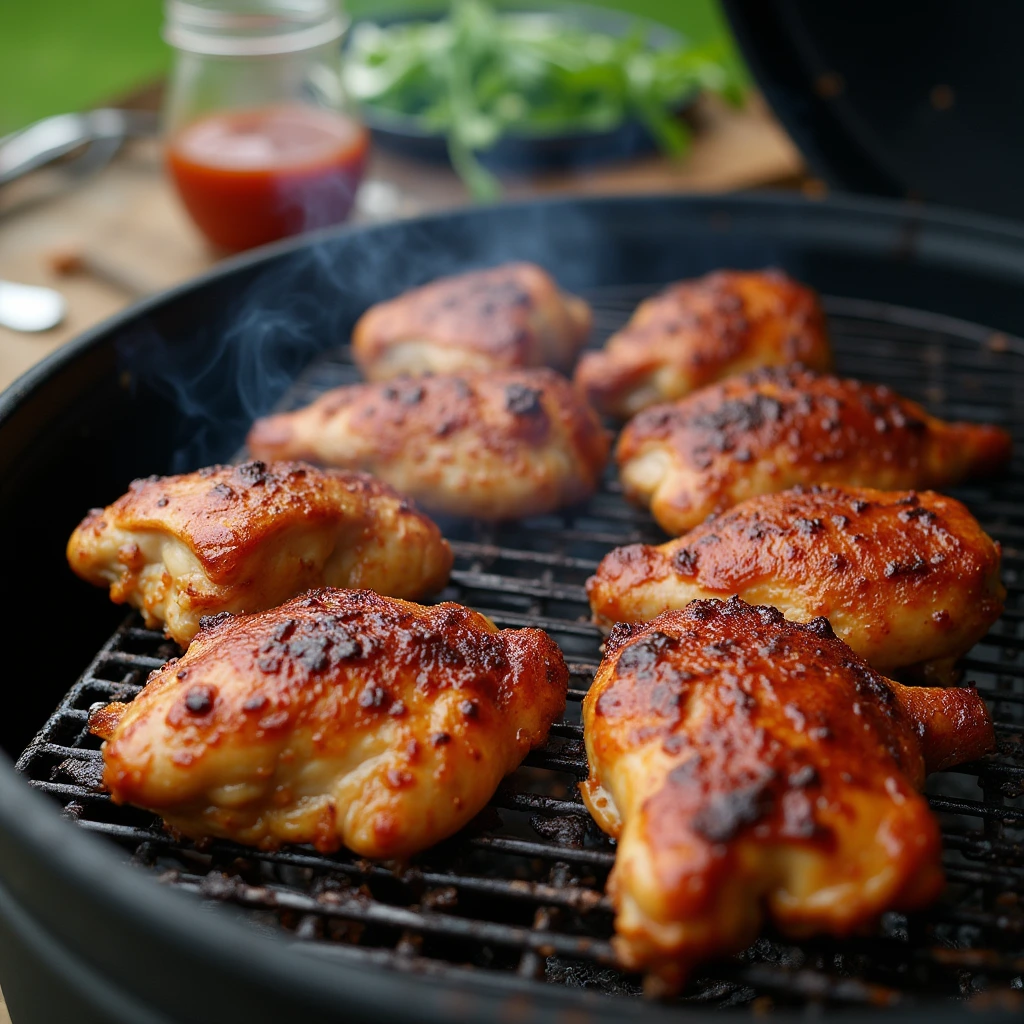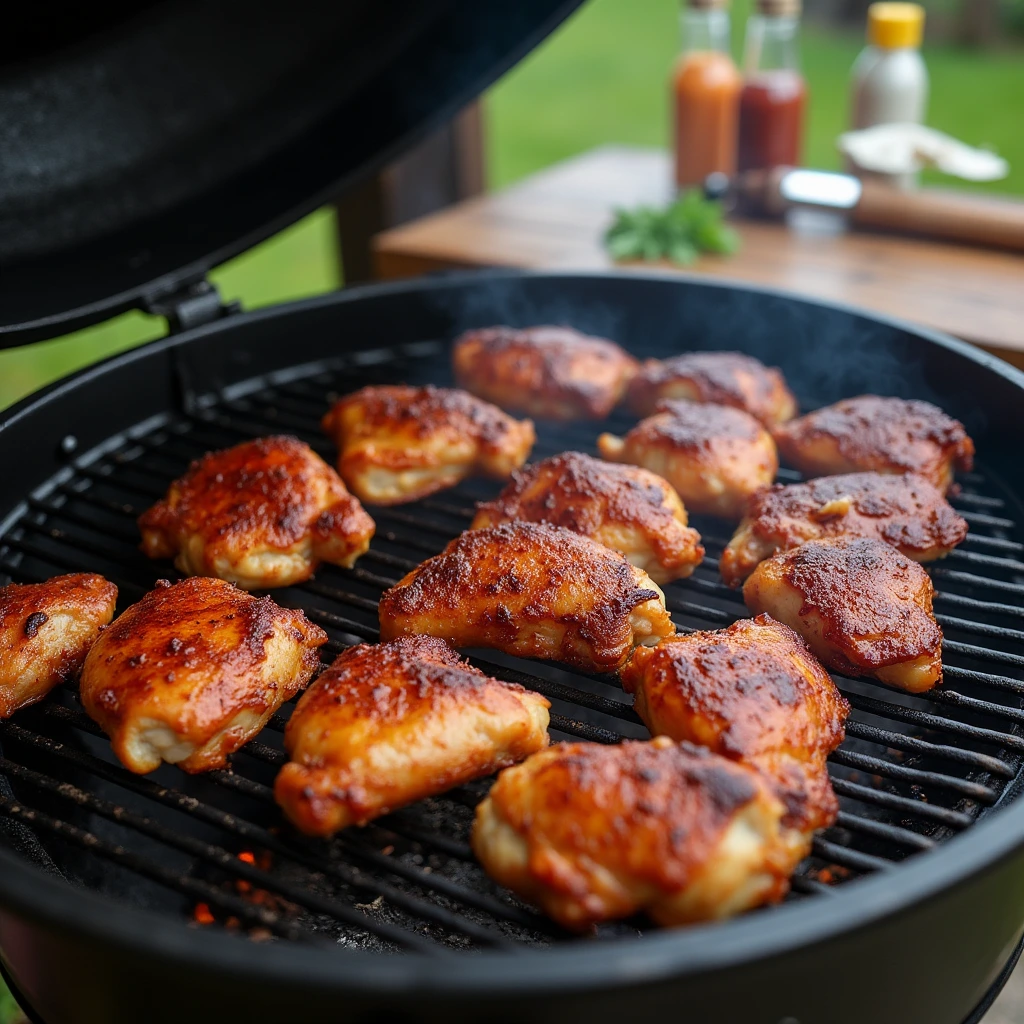About the Recipe
Smoking chicken thighs are a juicy and flavorful dish made by cooking the meat slowly with wood smoke. This method enhances the chicken’s natural flavors and adds a rich, smoky aroma. Whether coated in a simple rub or marinated with spices, these thighs are a favorite in many cuisines.

Smoking is an ancient cooking technique that tenderizes meat while keeping it moist. It blends science and artistry to create deep, unique flavors. Smoking transforms chicken thighs into a special meal, enjoyed at backyard barbecues and fine dining tables alike.
The Basics of Smoking Chicken Thighs
Smoking chicken thighs begins with understanding two primary methods: hot smoking and cold smoking. Hot smoking cooks the meat at temperatures between 225°F and 275°F, ensuring it’s both smoked and fully cooked. In contrast, cold smoking exposes the meat to smoke at lower temperatures, typically below 90°F, and requires additional cooking for safe consumption. Hot smoking is ideal for chicken thighs due to its efficiency and flavor development.
To achieve the best results, you’ll need essential tools like a reliable smoker, wood chips or chunks (such as hickory, cherry, or apple), a thermometer, and a drip pan. Smokers come in various types, including electric, pellet, charcoal, and offset models. When choosing a smoker, consider your experience level, budget, and desired flavor profile. Charcoal smokers offer rich, traditional flavors, while electric or pellet smokers provide consistent heat and ease of use.
Investing in quality tools and selecting the right smoker ensures evenly cooked, flavorful chicken thighs. Mastering these basics sets the stage for a successful smoking experience, whether you’re a novice or seasoned pitmaster.
Preparing Chicken Thighs for Smoking
Proper preparation is key to achieving tender, flavorful smoked chicken thighs. Start by trimming excess fat and loose skin to ensure even cooking. Rinse the thighs under cold water and pat them dry with paper towels to create a clean surface for seasoning.
For maximum juiciness, brining is a crucial step. Soak the chicken in a simple solution of water, salt, and sugar, or add spices and herbs for extra flavor. Brining helps the thighs retain moisture during the smoking process, resulting in a succulent texture.
Next, enhance the flavor with a dry rub or marinade. Dry rubs combine spices like paprika, garlic powder, and black pepper, creating a flavorful crust. Marinades, on the other hand, penetrate the meat with bold flavors through a mix of liquids like oil, vinegar, or citrus juice. Let the chicken rest in the brine or marinade for several hours or overnight for the best results.
Whether you prefer the simplicity of a dry rub or the depth of a marinade, proper preparation ensures your chicken thighs are flavorful and ready for smoking. These steps set the foundation for a delicious final dish.
Choosing the Right Wood for Smoking
The type of wood you use for smoking greatly influences the flavor of your chicken thighs. Different woods impart unique characteristics, making it essential to choose one that complements poultry.
Hickory delivers a strong, smoky flavor, ideal for those who enjoy bold tastes. Mesquite is even stronger, offering an earthy intensity, but it can overpower delicate meats like chicken if used excessively. For a milder, sweeter flavor, opt for fruitwoods like apple, cherry, or peach, which pair beautifully with chicken and enhance its natural taste. Maple adds a touch of sweetness, while oak offers a balanced smokiness that works well for most recipes.
When smoking chicken thighs, it’s best to use lighter woods like apple or cherry for a subtle, smoky profile. For richer flavors, mix stronger woods like hickory with fruitwoods to strike a balance. Avoid using softwoods like pine or cedar, as they can produce bitter, unpleasant flavors.
Selecting the right wood ensures your chicken thighs absorb the perfect amount of smoky flavor without overwhelming their natural taste. Experimenting with wood combinations allows you to create a signature flavor tailored to your preference.
Smoking Techniques and Temperature Control
Mastering temperature control is essential for perfectly smoked chicken thighs. Smoking works best in the low-and-slow range of 225°F to 275°F. This ensures the chicken cooks evenly while absorbing the rich, smoky flavor. Maintaining a consistent temperature is key; fluctuations can lead to uneven cooking.
To achieve even results, set up your smoker with distinct temperature zones. This can be done by arranging coals or adjusting burners to create direct and indirect heat areas. Place the chicken thighs in the indirect zone to avoid overcooking and allow the smoke to infuse gradually. A drip pan under the chicken helps control flare-ups and keeps the meat moist.
Monitoring the internal temperature of the chicken is vital for food safety and quality. Use a meat thermometer to check the thickest part of the thighs. Chicken is safely cooked at 165°F, but for a more tender, flavorful result, let it reach 175°F to 185°F, where the connective tissue breaks down.
By understanding temperature zones, practicing even cooking techniques, and closely monitoring internal temperature, you’ll achieve juicy, smoky chicken thighs every time. Consistency is the secret to mastering this art.
Step-by-Step Smoking Process
Smoking chicken thighs is a straightforward process when you follow these key steps.
- Preheat the Smoker
Begin by preheating your smoker to a temperature between 225°F and 275°F. Add your chosen wood chips or chunks to generate smoke. Allow the smoker to stabilize before placing the meat inside. - Prepare the Chicken
After trimming, brining, and seasoning the thighs, arrange them for even cooking. Pat the chicken dry before adding a dry rub to create a flavorful crust during smoking. - Arrange on the Grill
Place the chicken thighs in the smoker on the indirect heat zone, ensuring they are evenly spaced to allow proper airflow. Position the thighs with the skin side up to retain moisture and develop a crisp texture. - Set the Smoking Time
Smoke the chicken thighs for 1.5 to 2 hours, or until the internal temperature reaches 165°F. For extra tenderness, let them reach 175°F to 185°F. Monitor the temperature with a meat thermometer and avoid lifting the lid too often to maintain consistent heat and smoke levels.
Following these steps ensures evenly cooked, smoky chicken thighs with a tender and flavorful finish.
Tips for Perfectly Smoked Chicken Thighs
Achieving perfectly smoked chicken thighs requires attention to detail, but with the right tips, you can elevate your results.
- Avoid Common Mistakes
First, ensure the smoker temperature stays consistent, as fluctuations can lead to uneven cooking. Additionally, be cautious with the amount of wood chips you use, since too much smoke can create a bitter flavor. Lastly, always rely on a meat thermometer to prevent undercooking or drying out the meat. - Achieve Crispy Skin
While smoking at low temperatures enhances flavor, it can sometimes result in rubbery skin. Therefore, finish the thighs with a quick sear on a hot grill or increase the smoker temperature to 300°F for the last 20 minutes. This adjustment helps create a crisp, golden skin while preserving the meat’s tenderness. - Experiment with Flavors
To expand your repertoire, try blending different wood types like fruity apple or cherry with stronger hickory for balanced smoke. Moreover, don’t shy away from tweaking your rubs and marinades by adding sweet, spicy, or tangy ingredients.
By following these tips and making small adjustments, you can consistently create smoked chicken thighs that are flavorful, juicy, and perfectly cooked every time.
Flavor Variations and Seasoning Ideas
Smoked chicken thighs are incredibly versatile and can take on a variety of bold flavors. Experimenting with seasonings and sauces allows you to create unique dishes to suit any palate.
- Classic BBQ Flavors
Stick to the timeless combination of a sweet and smoky dry rub made with paprika, brown sugar, garlic powder, and a hint of chili powder. Finish with a tangy BBQ sauce during the last 15 minutes of smoking for a sticky, caramelized glaze. - Asian-Inspired Smoked Chicken
Create an Asian twist by marinating the chicken in soy sauce, ginger, garlic, and sesame oil. Add a sprinkle of five-spice powder for depth, and glaze with hoisin sauce or honey-soy during the final stages of smoking for a sweet-savory finish. - Spicy Cajun Rubs and Sauces
For a Southern kick, coat the chicken thighs in a Cajun rub made with cayenne pepper, paprika, oregano, and garlic powder. Pair with a creamy remoulade sauce or a spicy hot sauce for an extra layer of heat.
These flavor profiles demonstrate the versatility of smoked chicken thighs, making them a crowd-pleaser for any occasion.
Serving and Presentation Tips
Proper serving and presentation elevate smoked chicken thighs from delicious to unforgettable.
- Resting the Chicken
After smoking, let the thighs rest for 5-10 minutes. This step allows the juices to redistribute, keeping the meat moist and flavorful. Cover the chicken loosely with foil to retain warmth during resting. - Side Dish Pairings
Pair smoked chicken thighs with sides that complement their rich, smoky flavor. Classic options include creamy coleslaw, baked beans, or cornbread. For a lighter touch, serve with roasted vegetables, a fresh garden salad, or tangy pickles. Adding a dipping sauce, such as BBQ, ranch, or honey mustard, can enhance the flavor even further. - Plating for Visual Appeal
To make your dish visually stunning, arrange the chicken thighs on a platter with vibrant garnishes like fresh herbs, lemon wedges, or sliced chilies. Place side dishes in complementary serving bowls to create a cohesive, inviting presentation. For added flair, drizzle a glaze or sauce over the chicken thighs just before serving.
With proper resting, thoughtful side dish choices, and creative plating, smoked chicken thighs become a feast for both the palate and the eyes.
Health and Nutritional Considerations
Smoked chicken thighs are a flavorful option that offers a good balance of nutrition and taste. On average, one smoked chicken thigh (with skin) contains approximately 200-250 calories and 20-25 grams of protein, making it a high-protein choice for meals. Removing the skin can reduce fat content, lowering the calorie count while still providing lean protein.
Smoking is a healthier cooking method compared to frying. Unlike frying, which requires large amounts of oil and adds significant calories and unhealthy fats, smoking uses indirect heat and wood smoke to cook the chicken without additional fat. This method helps retain nutrients and enhances flavor naturally, eliminating the need for calorie-heavy breading or excessive seasoning.
Additionally, the slow-cooking process of smoking allows fats to render out of the meat, reducing overall fat content while keeping the chicken moist and tender. When paired with wholesome sides like vegetables or whole grains, smoked chicken thighs can be part of a balanced, nutritious meal.
By choosing smoking over frying, you enjoy a dish that’s lower in unhealthy fats while still delivering satisfying flavors and nutritional benefits.
FAQs
1. Is it better to smoke chicken at 225 or 250?
Both temperatures work well, but smoking at 250°F is often preferred for chicken thighs. The slightly higher temperature helps render fat and crisp the skin faster while still maintaining the juicy, smoky flavor. Smoking at 225°F takes longer and may lead to rubbery skin if not finished with higher heat.
2. How long to cook chicken thighs at 250 degrees?
Chicken thighs typically take 1.5 to 2 hours at 250°F. Always check the internal temperature with a meat thermometer; the chicken is safe to eat at 165°F, but letting it reach 175°F to 185°F produces a more tender and flavorful result.
3. Should I flip chicken thighs when smoking?
No, flipping is unnecessary. Smoking uses indirect heat, which cooks the chicken evenly without flipping. Keeping the skin side up allows it to crisp while the meat remains juicy.
4. How to smoke chicken thighs without rubbery skin?
To avoid rubbery skin, increase the smoker temperature to 300°F during the final 20-30 minutes or finish the thighs on a hot grill. Patting the skin dry before seasoning also helps achieve crispiness.
Additional Resources for Perfectly Smoked Chicken Thighs
For further guidance on smoking chicken thighs and enhancing your barbecue skills, several trusted online resources offer expert tips, recipes, and equipment reviews. The National Barbecue Association provides comprehensive information on smoking techniques, wood selection, and safety tips, perfect for beginners and enthusiasts alike. If you’re searching for specific recipes or flavor combinations, visit Meathead’s AmazingRibs.com, a highly respected site offering science-based grilling and smoking advice.
For in-depth reviews of smokers and tools, check out The Smoker King, where you’ll find comparisons of different smoker types to help you choose the right equipment for your needs. Additionally, BBQGuys.com is an excellent source for purchasing high-quality smokers, grills, and accessories.
To dive deeper into flavor experimentation, the Spice House offers an extensive range of rubs, marinades, and spices specifically designed for smoked meats. Lastly, FoodSafety.gov is an invaluable resource to ensure your chicken thighs are cooked safely and stored correctly.
These external resources provide everything you need to confidently tackle smoked chicken thighs and expand your barbecue repertoire, whether you’re new to smoking or a seasoned pro.
You can discover more recipes on our website:
Conclusion
Smoked chicken thighs are a delicious and versatile dish that combines rich, smoky flavors with tender, juicy meat. By understanding the basics of smoking, such as selecting the right wood, maintaining consistent temperatures, and preparing the chicken with brines, rubs, or marinades, you can elevate your culinary skills and create a memorable meal.
Perfect results come from attention to detail—using a meat thermometer to monitor internal temperatures, avoiding common mistakes, and experimenting with flavors. Whether you prefer classic BBQ, Asian-inspired marinades, or spicy Cajun rubs, smoked chicken thighs can cater to a variety of tastes.
Beyond flavor, smoking is a healthier alternative to frying, offering a method that enhances the meat’s natural goodness without adding unnecessary fats. With proper resting, thoughtful side pairings, and creative plating, you can transform your smoked chicken thighs into a visually stunning and satisfying feast.
Now that you have the tips and techniques, it’s time to fire up your smoker and give it a try. Smoking chicken thighs not only rewards you with great food but also the joy of mastering a time-honored cooking tradition. Dive in and make your next meal unforgettable!

